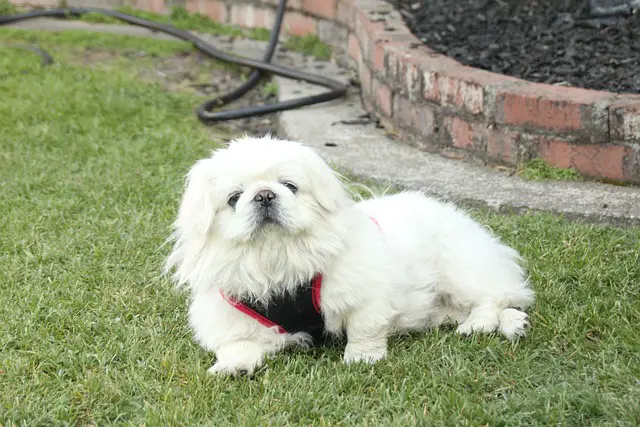9 Most Simple Pekingese Training Tips

Let’s break down some easy Pekingese training tips you should know…
This article will serve as a guide to the fundamental training that Pekingese dogs, like other dogs, require.
As soon as you can, you should begin teaching your Pekingese because as they get older, they become more resistant to instruction.
Let’s now outline and talk about the typical fundamental training that your Pekingese requires in order to be content and healthy.
Pekingese Training Tips
One of the most well-known dog breeds in the world, the Pekingese is bright and simple to teach.
Like most dogs, Pekingese require exercise and care, but they also require instruction in the fundamentals of obedience.
Pekingese are absolutely trainable canines if you are willing to put in the time and effort.
Here are some useful Pekingese training tips you should know:
1. Basic training

Obedience training is the cornerstone of effective dog training, so start there.
Teach your dog the fundamental commands, including come, sit, stay, and down.
Here are some pointers for teaching obedience:
- Clearly define your dog’s behavioral expectations and guidelines.
- Apply these guidelines and expectations consistently.
- With your dog, exercise consistency and patience.
- Give your dog praise for good behavior by using positive reinforcement.
- Avoid punishing your dog with physical force.
Expect little from your Pekingese during basic training, and always give the instruction again until your dog understands it.
Keep in mind that training a dog is a lot simpler when they know you have a reward for them, like biscuits.
Since each Pekingese has a unique personality, there is no set basic training term or time limit.
However, you ought to finish the fundamentals in less than 4 weeks.
2. Confinement training
Use a crate to confine your dog when you’re not home throughout the crate-training process.
A cozy bed, a water bowl, and a specific area for the dog to relieve himself should all be included in the crate.
Here is some advice for crate-training your Pekingese:
- Your dog should first be confined to the crate for brief intervals before the time is gradually extended.
- Use a crate as a secure sleeping and relaxing area for your dog.
- Maintain the cleanliness and comfort of your dog’s kennel.
- Give your dog cookies or toys as a reward for excellent behavior in the crate.
- As you train your dog to behave in the crate, be patient and persistent with your instructions.
As each Irish terrier is unique in personality, there is no set amount of time that should pass before starting to cage train your Pekingese.
The Pekingese crate training process can, however, be finished in less time than 12 weeks.
3. House training
Increase the amount of time your dog spends using the restroom by starting off gently.
To assist your dog in following through with toilet training, use a timetable.
When your dog relieves himself inside, reward him. After each productive pee trip, take your dog for a walk.
Always remember the following:
- After meals, take your Pekingese to the restroom.
- Before eating, take your Pekingese to the restroom.
- Take your Pekingese to the bathroom as soon as he wakes up from sleep.
- Make sure to take your Pekingese to the bathroom before night.
- Before and after each segment of exercise, take your Pekingese to the restroom.
- Finally, during your training sessions, you should take your Pekingese to the bathroom at least 7 to 10 times per day.
- With your dog, exercise consistency and patience.
4. Socialization
One of the most crucial aspects of training a Pekingese is socialization since it greatly affects how your dog perceives other animals.
A Pekingese that has been properly socialized will be at ease with other animals and probably bark less.
Unsocialized Pekingese might become more aggressive and engage in pointless fighting or biting because they perceive humans or other animals as dangerous.
The following are some pointers for interacting with your Pekingese:
- Introduce your dog to more people, dogs, and animals over time by introducing them to fewer at first and then more.
- A lot of toys that you and other people may play with should be available for your dog.
- Maintain consistency in your dog’s training, and give them treats when they behave well.
- Give your dog wholesome food and water, as well as frequent exercise.
- Ensure that your dog has a cozy area to sleep in, and keep them entertained by giving them toys and treats.
5. Tricks training
To keep your Pekingese occupied and content, you may teach them a variety of skills.
The following advice will help you teach your Pekingese tricks.
- Start with simple instructions like “sit,” “stay,” “come,” and “down.”
- Treats can be used as a carrot to entice a dog to learn new tricks.
- When the dog successfully completes a trick, praise it.
- Repetition is the key to teaching a dog a trick.
- Be persistent in your workout regimen and patient with yourself.
6. Positive reinforcement training
Rewarding excellent behavior with sweets, toys, petting, or other enjoyable activities is known as positive reinforcement.
Basic obedience is taught through human-directed training methods such as vocal instructions, hand signals, and sit, stay, and come.
When your dog is not doing things correctly, you should always offer positive reinforcement. Because they are not people, don’t be angry with them.
7. Set boundaries
Set boundaries for your dog and be consistent with your directions.
No dog ought to be permitted to leap up on humans, destroy furniture, or act erratically.
Setting rules, restrictions, and boundaries that will serve as your Irish terrier’s guidelines is an essential component of teaching him.
Rules like “don’t climb on people or eating tables,” “don’t follow me into the restroom,” “don’t beg for food,” etc. are included in this list.
These guidelines should be followed together with obedience training and the use of orders.
In order to encourage your dog to obey your directions, use positive reinforcement.
It will be simpler for him to obey your directions in the future if he associates compliance with incentives.
If your dog doesn’t obey your orders the first time, be ready to give them again. Your dog will learn your orders more effectively with repetition.
Read more: Can Pekingese Be Left Alone & For How Long?
8. Reward training
Reward your dog for good conduct by providing positive reinforcement. You may do this by giving your pet goodies, pet attention, or vocal praise.
Train with valuable bonuses. You’ll be astonished at how much harder your dog will work for a small piece of chicken breast, cheese, or liver compared to even the greatest store-bought treats.
You need to perform at your highest level when times are difficult. In settings free from interruptions, such could function.
Soft treats for training should be used so you may keep educating your dog without having to stop and wait for him to complete chewing.
The following advice can help you please your Pekingese during training:
- Ensure that your dog enjoys the treats you give him.
- Use tiny treats often, and when your dog displays desired behavior, increase the prize.
- Teach your dog to link excellent behavior with positive reinforcement by being consistent with your incentives.
- Rewarding bad behavior with punishment will simply make your dog less likely to behave.
- Be patient with your dog during the training process and have fun—rewards will follow!
Learn more about how to stop a dog from whining for attention.
9. Exercise training

Playtime is essential for both people and dogs.
Both humans and dogs need to unwind and engage in enjoyable activities.
To prevent a Pekingese from developing play aggressiveness, which may be problematic for both you and your dog, playtime training is also essential.
Here are some pointers for training your Pekingese during playtime:
- Start with quick, enjoyable workouts and progressively lengthen and intensify them.
- When the dog successfully completes the job, use positive rewards like food or praise.
- Never force the dog to perform something it doesn’t want to do throughout training.
- Various instructions can be used to elicit a response from the dog.
- Avoid giving the dog any physical punishment, such as beating or scolding.
Learn more about simple exercises for your Pekingese.
Related Questions
How do I get my Pekingese to quit digging?
Give the dog lots of mental and physical activity, use positive reinforcement to promote non-digging behavior, and divert digging behavior to a suitable substitute.
How can I keep a Pekingese from getting separation anxiety?
Increase the amount of time the dog is left alone gradually, give him lots of mental and physical activity, and leave him with familiar objects like a blanket or toy.
How can I discipline a Pekingese for being aggressive?
Determine the causes of the aggressive behavior and use training to address them.
Use tactics for positive reinforcement rather than punitive correction to encourage good conduct. Consult a qualified dog trainer if necessary.
How can I potty-train a Pekingese?
Create a schedule for routinely bringing the dog outside and praising successful eliminations. Utilize techniques for positive reinforcement, such as snacks and praise.
How can I teach a Pekingese the fundamental commands?
Utilize positive reinforcement strategies, like cookies and praise, and begin with basic commands like “sit” and “stay.” Patience and consistency are essential.
Learn more about behavior problems in Pekingese.
How can I get my Pekingese to stop barking so much?
Determine what causes the barking and train your dog to deal with it, maybe by teaching a “quiet” command. Reward the dog for being quiet rather than penalizing it for barking.
Learn more about some common dog training mistakes.
Conclusion
Let’s sum up by saying that training a Pekingese may be beneficial and fun for both you and your dog.
You can assist your Pekingese in realizing their full potential if you have the right information and dedication.
Your dog will develop into a well-behaved and devoted friend if you use positive reinforcement, establish clear expectations, and offer persistent, patient direction.
You may effectively teach your Pekingese and enjoy many years of friendship and delight with the appropriate technique and patience.
